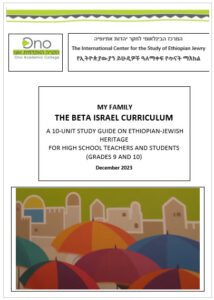
UNDERSTANDING ETHIOPIAN JEWISH HERITAGE AND IDENTITY
PREFACE BY RABBI DR. SHARON (ZAUDE) SHALOM,
DIRECTOR OF THE INTERNATIONAL CENTER FOR THE STUDY OF ETHIOPIAN JEWRY
ONO ACADEMIC COLLEGE
ETHIOPIAN BOYHOOD
I have been engaged for years in extensive anthropological fieldwork documenting the heritage, culture, and traditions of the Beta Israel community, more commonly known in the Diaspora as Ethiopian Jewry. As an Israeli rabbi, scholar, and immigrant born in Ethiopia among this unique Jewish community, my profound interest and commitment are both professional and personal.
Growing up in a tightknit Jewish community in a small Ethiopian village, I experienced firsthand the Beta Israel’s unwavering devotion to the values of Judaism and Zionism. I absorbed throughout my boyhood an everlasting love for Jerusalem, praying and dreaming of our eventual return. I remember sitting on my grandfather’s lap, as he held a small red book of psalms close to his heart. Along with the Beta Israel spiritual leaders, my grandfather chanted psalms in our ancient Ge’ez language, accompanied by drums and cymbals. How we all cherished the holy writings of our tradition! Each day as a child, I witnessed the Beta Israel community uplifted in passionate liturgy and faith. Within the framework of my academic research, I have been fortunate to develop close relationships with Beta Israel spiritual leaders (kessim), as well as our elders and sages (shimageleoch), gaining deeper insight and appreciation of our heritage.
The Beta Israel is an integral part of Diaspora Jewry, yet our culture and traditions are rarely understood through the lens of our own experiences. In my contribution to My Family – The Beta Israel Curriculum, I wear two hats: I am both an academic researcher and a living testimonial to the wonders of Ethiopian Jewish history.
LIVING VESTIGE OF BIBLICAL JUDAISM
The Beta Israel is unlike other Jewish communities in that our heritage is rooted in a biblical tradition of “Torah she be’al peh”, or oral Jewish law, as opposed to the rabbinic traditions that shaped most of Diaspora Jewry for millennia. Ethiopian Jews, like other Jews, believe that our forefathers and foremothers stood at the foot of Mount Sinai and received the Torah upon exodus from Egypt. Yet we do not share in the mosaic of rabbinic Judaism that developed after exile from ancient Israel and Judah.
The Jews of Ethiopia are even different from the Jews of Yemen, despite our relative geographic proximity. The Jews of Yemen, after all, knew about the Mishnah (redacted in 200 CE), the Talmud (200- 600 CE), Gaonim (600-1000 CE), Rishonim (800-1200 CE), the Shulkhan Arukh (1563 CE), and other rabbinic teachings. The Beta Israel was not touched by this rabbinic world, or these works, until just over a century ago. Neither was the Beta Israel impacted by the foundational historical events and developments that occurred in exile after the destruction of the Second Temple in Jerusalem (70 CE).
In effect, the Beta Israel had no connection to the textual canons that influenced and contoured Diaspora Jewry. Ethiopian Jewish heritage, traditions, and ritual practice, as a result, took on vastly different characteristics from other communities. Due to generations in isolation, Ethiopian Jewish customs are dissimilar – and unfamiliar – to most of Diaspora Jewry. While these differences enhance the singularity of our communal identity, it has also created barriers between the Beta Israel and other Jews, especially in the State of Israel. After the mass aliyah of Ethiopian Jews in Operation Moses (1984-1985), Israel became a veritable living museum of a Jewish community from another epoch and cultural period – a time capsule of Jewish history, in a sense.
Understanding the Beta Israel means delving into a parallel world of Jewish development and heritage. Most Ethiopian Jews now live in Israel, North America, Europe, and other Western nations. Although some have adapted to mainstream Judaism, many (especially in Israel) have tried, and to an extent, succeeded, in maintaining our unique heritage.
My Family – The Beta Israel Curriculum highlights for teachers and students the unique characteristics of a Jewish community that sustained its heritage and identity over the course of centuries, in complete isolation, developing a religious communal life based on biblical traditions, rather than rabbinic thought. The fact that Ethiopian Jewry thrived and survived without access to the Mishnah, Gemara, or the traditions of the sages (Chazal), makes the community especially worthy of study and understanding. It also underscores the crucial need to sustain the Beta Israel’s unique communal traditions, customs, and heritage, as these may well be lost in generations to come.
The glaring differences between the traditions of the Beta Israel and those of mainstream rabbinic Judaism led the religious institutions in the State of Israel to cast doubt about our Jewish identity, especially when we arrived as immigrants. Israelis tried to understand our Jewish culture by looking at us almost as a foreign specimen, using tools of social science to contend with questions regarding our ethnic origins, need for religious conversion, discrepancies in traditions and customs, and even observations and degradations about our skin color. The religious culture of the Beta Israel was researched and approached, in large part, within the framework of Orthodox halakha. To put it more simply, those who tried to study and explain the traditional world of the Beta Israel did so through the external lens of rabbinic Diaspora Judaism – rather than from our own “insider” communal perspective.
FOLKLORE VERSUS RELIGIOUS EXPERIENCE
Many Ethiopian Jews have resorted to explaining our traditions as though folklore, to be more digestible to public understanding. Folklore, in this sense, refers to a softening in meaning of our traditions and heritage: presenting customs as though cultural, rather than deeply religious. A good example of this is the Sigd holiday, an important fall festival symbolizing our acceptance of the Torah. Although public awareness of Sigd has grown in Israel in recent years – a positive development, to be sure – there is still an evident lack of appreciation for the explicitly religious character and significance of the holiday. More Jews may now know about Sigd, but most still don’t understand that it is a religious holiday. In Israel, Sigd may soon become a national festival centered on eating Ethiopian sourdough teff bread (injera), in the same way that the Sephardic Moroccan Jewish holiday at the end of Passover, Mimouna, is seen by most Israelis as an opportunity to eat sweet mufleta pastries and crepes, without deeper significance.
The painful reality is that Ethiopian and Sephardic (or Mizrachi) customs are treated by Israel’s religious establishment as secondary to Ashkenazi dictate. To demonstrate this difference, I cite an example from the late Rabbi Shlomo Zalman Auerbach, one of the foremost Israeli Ashkenazi poskim (legal scholars) of Jewish law. Rabbi Auerbach was once asked whether a Jew can make egg salad from hard-boiled eggs on Shabbat. He ruled that it was indeed permissible, basing his religious decision on his own grandmother’s Shabbat customs. In this sense, Rebbetzin Auerbach, or Rebbetzin Feinstein, or any other righteous Ashkenazi woman linked to a righteous Ashkenazi rabbi, was engaged in a “holy” custom; the posek ruled as such, no? But when it comes to Grandma Azizah of Morocco, her customs are considered folklore, not religious ruling; and when Grandma Lemlem of Ethiopia explains her Shabbat preparation, she is not even considered “Jewish enough” – in fact, she must undergo “backup” conversion, just to be sure. In my eyes, this approach, which erases entire familial customs and traditions, and asserts stringent halakhic standards, is a kind of religious paternalism and even colonialism. This approach, especially in Israel, has seeped into the treatment of Ethiopian Jews with the same derision that was applied to the Sephardic (or Mizrachi) immigrants from the Middle East and North Africa in the 1950s. Those early immigrants to Israel got the message and started to muddle their traditions, for the sake of inclusion. The Beta Israel is firm in its response to this form of cultural assimilation and erasure: We will not abandon the customs of our Ethiopian Jewish heritage, as the Jews of Morocco, Yemen, and so many other non-Ashkenazi communities were forced to do.
COMPLEMENTARY POLES
From my perspective, the meeting between Israeli and Ethiopian Jews was not just a charged interaction between veteran immigrants and new immigrants, nor even between white-skinned and black-skinned Jews. Rather, it’s a meeting between two poles of Judaism: Biblical Judaism and Rabbinic Judaism. The nexus of these two models of Judaism exists in a common domain: the State of Israel. In the curriculum presented here, we explain the essential differences between these two traditions, and argue that there is equal merit and spiritual significance to both. Although Jews are famous for disputing at length contrary approaches to religious law, this is perhaps the first time in history that the Talmudic tradition of Rabbinic Judaism and the pre-Talmudic tradition of Biblical Judaism have met in direct opposition. Ethiopian Jews are proud of our distinctions – we do not see them as obstacles to faith. In fact, these differences – and dearth of public awareness – is what makes the Beta Israel one of the most fascinating Jewish communities today. These poles of Judaism can indeed be complementary – not contradictory.
BALANCING ACT: RESPECT AND “SOCIAL DISTANCING”
The Beta Israel is familiar with the difficulties of maintaining distinct customs as a minority community. These challenges have shaped our traditions. In Ethiopia, it was essential for the Beta Israel to preserve its unique religious heritage, while maintaining friendly relations with Christian neighbors. A varied system of customs thus developed to facilitate hospitable interactions with non-Jews. On the one hand, it was considered a given that all humans are equal before G-d, and that human nature is inherently good. On the other hand, in an overwhelmingly non-Jewish environment, Ethiopian Jews had to strive mightily to sustain their heritage. As part of these efforts, the Beta Israel abstained from direct contact with non-Jews, while still extending hospitality at a distance. For example, Ethiopian Jews made a point of inviting their Christian neighbors to take part in celebrations – but seating for the groups (Christians and Jews) was separate; this was acceptable to both sides. When a Jew invited a non-Jew to join her for coffee, they sat at a distance from each other. In certain cases, the Beta Israel even kept a separate set of dishes for hosting their non-Jewish neighbors. In these ways, the Beta Israel maintained a respectful form of social distancing that allowed friendship without compromise of heritage, identity, or tradition.
MUTUAL DEPENDENCY
Among the core values instilled in me as a Jewish child in Ethiopia was the notion of mutual dependence – that everyone needs the support of another. For example, in a neighboring village, residents excelled at raising sheep and cattle; in my own village, we were experts at yielding crops and legumes. One day as a boy, I was surprised to see ten goats suddenly appear in our yard. My parents explained that they had bartered ten bags of teff flour and legumes to a family in a neighboring village, in exchange for ten goats. Mutual dependency in action: our village now had goats, and the neighbors had teff and legumes.
This reminds me of the homiletic drasha of the rabbinic sages on the Four Species of plants we wave during the Sukkot (the Festival of Tabernacles). These Four Species can be considered analogous to four types of Jews (Midrash Leviticus Rabba 30, 12): Jews who are versed in the ways of the Torah, and practice mitzvot are like the etrog (the citron), which has both taste and aroma; Jews who are versed in the Torah, but do not excel in the practice of mitzvot are like the lulav (palm branch), a plant that yields tasty fruit, but no special aroma; then, there are Jews like the hadas (myrtle), which has aroma, but no taste – like those who observe mitzvot but are not versed in the meaning; and lastly, there is the arava (willow), a plant bereft of both taste and aroma, symbolizing a Jew who lacks both learning and mitzvot.
Together, these Four Species – and similarly, the Jewish people – complement each other; each comprise the whole. One fills in a characteristic where another lacks. A member of the Beta Israel community once challenged me on this analogy, and said, “Who is making up for whom? After all, each stream of Judaism, each group, thinks that it is the etrog, the wholly righteous species, while the other groups, they must be far from the truth. Everyone believes that only ‘my group’ contains the one truth.”
But the midrash, in fact, conveys the idea that the whole truth does not reside within any single camp. All characteristics and virtues belong to the collective people of Israel, and we each need one another to be whole. It does not help the etrog to have both taste and aroma, because a Jew cannot fulfill the mitzvah of the Four Species with an etrog alone. In that vein, we must expand the boundaries our traditions as both Jews and humans. We must understand that each group has some special talent or knowledge that other groups do not. Even one who seems externally devoid of contributions, essentially to the overall well-being of the group. The Talmudic rabbis said in that even the “emptiest” among the people of Israel are as full of mitzvot as a pomegranate is packed with seeds (Sanhedrin 37a).
We can apply this idea to Ethiopian Jewish customs and practices. Among the deep meanings of the Sigd holiday is the notion that it gives everyone a chance for “truce,” enabling universal mutual trust; on this holiday, Jews break down the walls and barriers that divide individuals and villages from each other; Sigd gives us the opportunity to renew our biblical covenant and express our shared faith in Jerusalem. Sigd allows us to create a world without suspicion, imbuing communal life with a sense of unity and security.
COPING WITH CATASTROPHE
A core value promoted by Ethiopian Jewry is the understanding that we do not have full control over our own lives or destinies. Paradoxically, this knowledge invigorates our ambition to succeed. Modern man and woman strive for personal empowerment and autonomy, but those qualities expose us to unbridled fear and anxiety. So many people are terrified of losing control of themselves, of landing on the bottom rung of the ladder of happiness. So, what is the antidote to this fear?
Ethiopian Jews experienced these emotions during our long walk through the Sudanese desert in 1981, as we journeyed to an encampment on the Sudanese-Ethiopian border, from where we hoped to be transported to Eretz Yisrael. This arduous trek, filled with challenges, taught us to place our faith in the Holy One Blessed be He, and to know that G-d is at the very center of our lives. This gives us an ability of feel the proximity of G-d in every situation, in the highs and lows of life, in the hours of success, in the hours of failure, and in both the dull and exciting routines of life. This deep emunah (faith) carried the Jews of Ethiopia through the desert as we awaited our own exodus, and through other difficult times.
My Uncle Daniel Mengasha, may he rest in peace, was a great Jewish scholar. Once, I asked him whether the goal of prayer was to get something from Hashem or to give something back? Does the flow stem from humans to G-d, I asked, or from G-d to humans? Uncle Daniel answered: “Anyone who thinks he is giving something to G-d has tremendous chutzpah. We only receive from G-d.” In Uncle Daniel’s view, prayer is an act that educates man to receive from G-d. The thought that I, as a human, can give something to G-d through prayer, is a dangerous concept. One of the deeper meanings of tefillah (prayer), is that it is a nechama (comfort), and that nechama is tefillah. Tefillah, as such, is not an act geared toward changing one’s life situation; it is rather about accepting the situation.
Connecting with our Creator is the greatest comfort. Rather than feeling alienated by this idea, we can look toward the advice given in the Book of Psalms, “Closeness to G-d is good for me” (73:28). My grandmother, like many other elders in Ethiopia, lost six of her children. Nevertheless, she was able to accept this horrific loss, and lead a normal life, with the knowledge that everything – good and bad – comes from the Master of the Universe. Likewise, the prayer of Moshe Rabbeinu to enter Eretz Yisrael (Book of Deuteronomy) was a great comfort to him, regardless of whether this desire would be granted by G-d, or not.
This understanding is what led many Holocaust survivors to continue to push ahead in life, against all logic, and in defiance of the torture they experienced during at the hands of the Nazis. This perspective on prayer might well be an antidote to the pervasive idea within Western culture, that we as humans, are deserving of that which is due to us. Only G-d decides what we deserve, and how it is due.
THE BLAME GAME VERSUS EXISTENTIAL RESPONSIBILITY
Modern Jews can learn much from Ethiopian Jewry’s approach to the ancient conundrum of individual blame versus collective guilt. This is expressed in two seemingly contradictory verses: In Exodus 34:7, it is written: “…yet He does not acquit, reckoning the sin of the fathers over sons… to the third generation and the fourth.” In Deuteronomy 24:16, however, it says: “Fathers shall not be put to death over sons, and sons shall not be put to death over fathers. Each shall be put to death for his own offense.”
To understand the complexity of these biblical verses, it is helpful to look at Megillat Eichah (the Book of Lamentations), which is focused on the churban (destruction of the Holy Temple in Jerusalem), and the terrible suffering that befell Jews in its wake. A series of questions can be posed to this regard: Are horrendous life situations punishment for sin? How can we truly understand whether sins are visited upon ensuing generations or if people die for their own sins? Who is guilty and who is deserving of punishment? On the one hand, perhaps the guilt lies with previous generations, or even earlier, with the generation of our forefathers and foremothers. Could it be that our ancestors sinned, and although they are no longer here, we as Jews are forced to suffer from their misdeeds? On the other hand, perhaps the responsibility lies with the generation of the children, as per the verse, “The crown of our glory has fallen, Woe is to us, for we have sinned” (Lamentations, Eichah 5:16). In other words, are catastrophes inherited or are they created independently, with no connection to the sins of past generations?
Professor Avi Sagi, an ethicist at Bar-Ilan University, suggests that these questions did not preoccupy the generation who witnessed the destruction of the Holy Temple. That was the generation of the Prophet Ezekiel who stated, “The son shall not bear the iniquity of the father with him, neither shall the father bear the iniquity of the son with him” (Ezekiel 18:20). Before the destruction of the Temple, the generation of that time popularized the following metaphor: “The fathers have eaten sour grapes and the children’s teeth are set on edge (Ezekiel 18:2, also Jeremiah 31: 28). However, when the tragedy of the Churban came, that generation justified it as due punishment: “We sinned and rebelled…” (Lamentations, Eichah 3:42). In tractate Makkot of the Gemara, it is specified that although Moshe Rabbeinu assigned responsibility to future generations (“…reckoning the sin of the fathers over sons” Exodus 34:7), Ezekiel then came and canceled it, with the notion that, “… only the soul who sinned shall die; the son shall not bear the iniquity of the father” (18:20). So, herein lie the perpetual questions: “Who is responsible for a given catastrophe? And who must pay the price?”
In Ethiopian Jewish culture, we have a response. Our theology is encapsulated within the idea of a collectivistic “existential responsibility,” whereby no man exists in a vacuum, but rather, is an integral part of the past, present, and future. One of the leading Ethiopian Jewish spiritual leaders, Rabbi Reuven Tal Yaso, illustrates this with the example of the Egla Arufa, the ritual response to an unsolved murder, as described in the Book of Deuteronomy (Devarim 21). From a purely legal view, there is no need for a ritual ceremony involving the slaughter of a heifer. However, because the murdered person happened to be in a geographic area under the supervision of elders, the “existential responsibility” belonged to them. To cite Professor Sagi again, there is no legal indictment in this situation, but rather, room for “existential responsibility,” a means for atonement to correct the social faults that led to a tragic outcome. As told by Professor Sagi, humans “are thrown into a given history, culture, and environment not of their choosing.” People are born into a reality and do not just “float in from the sea.”
To return to the generation of the churban (destruction of the Temple) the issue was not “legal blame,” but rather “existential responsibility.” We can see this in the way the Beta Israel handled a tremendous theological disappointment: After the first major aliyah, when Ethiopian Jews arrived in the State of Israel, many made a pilgrimage to Jerusalem, assuming they would see the Holy Temple standing in all its glory. For these Ethiopian Jews, the “destruction” of the Temple occurred when they were personally confronted with the fact that it had not been standing for over a millennium! This was a cruel reality for them to encounter. What was their reaction? Did they look for someone to blame? No, on the contrary. The Ethiopian Jewish immigrants assumed that they – or more precisely, their generation – had to take “existential responsibility” to change this reality. Our ancestors must have sinned, and because they are now gone, we bear the burden to transform reality. This is not about blame, but rather our collective existential responsibility, for the past, present, and the future. From this perspective, it is a partnership with the Holy One Blessed be He, as expressed in the verse, “Return, Hashem, to us and we will return our days as of old” (Eichah 5:21). This is not a wail of despair at all, but rather, but a cry for hope.
ETHIOPIAN JEWISH VALUES
The conundrum above is just one example of how the Ethiopian Jewish narrative bases itself on values that have largely been shunted within modern Western culture. In this case, the Ethiopian Jewish value of “collective existential responsibility” counteracts the Western emphasis on individual autonomy. Other traditional values that remain strong among Ethiopian Jewry include steadfast respect for our elderly and unwavering filial piety; humility, equality, trust, and faith among all people; enduring family values, including the sanctity of marriage; unending love for Zion and the Land of Israel; a strong Jewish identity formed with an open mind to the surrounding world; a sense of fate and of purpose, and a pluralistic outlook on life, with the belief and understanding that all humans are inherently different, and as such, their viewpoints and perspectives will differ.
This “insider” voice of Ethiopian Jewry is important to hear among the chorus of voices shaping Jewish identity today. Until now, education about the history of Ethiopian Jewry has largely focused on telling stories about our community, rather than exploring and explaining the underlying values we hold dear. The former approach broadcasts the weaknesses and losses of our community, rather than celebrating our strengths and beliefs.
My Family – The Beta Israel Curriculum seeks to correct this imbalance, by expressing our values and experiences through our own tools and disciplines. In this curriculum, we will try to understand how Ethiopian Jews comprehended the Jewish world through generations of isolation, as well as after our mass immigration to the State of Israel. This program of study explores our theology, customs, traditions, culture, and our eternal faith in Zionism. Important lessons on the development of Jewish values and customs can be drawn from the Beta Israel’s experience, as we consider the halakhic pluralism of Ethiopian Jewry, and study how our communities came to live together despite our differences. From this unique position, we can build a shared vision of a pluralistic and respectful future.
HIDDEN TREASURE
The religious culture of Ethiopian Jewry is a treasure trove, a kind of living genizah or archive that has only recently been revealed to the world at large. Our hope is that this curriculum on the Beta Israel can serve as a platform and opportunity for engaging in conversation with the religious and intellectual sources of different Jewish ethnic and geographic groups. Studying the sources of Ethiopian Jewish religious history can undoubtedly provide students with an intellectual springboard for understanding the wider breadth of Jewish values and contribute to the development of their personal religious and national identities in new and exciting ways.
As Professor Tova Hartman, Dean of Humanities and Social Sciences at Ono Academic College, is wont to say, “I respect you as a person and as a Jew from Ethiopia. But even more so, I value you because my Jewish world is not complete without yours. Your existence makes me a better Jew.”
A corollary of this idea is that curriculum that explores the religious and cultural treasures of Ethiopian Jewry can help promote the understanding that there is not one Judaism. Rather, Judaism includes a wide spectrum of approaches for embodying our religious traditions, halakhic rulings, familial customs, and communal culture. Students will learn to appreciate the broadness of Judaism, as they encounter different sources of Jewish creativity, from different periods and communities, each of which have contributed greatly to our modern Jewish society, both in Israel and in the rest of the world. Moreover, students will learn that halakhic problems have more than one solution, as Professor Sagi so poignantly noted.
Students will learn that scholars over the course of generations have disagreed with one another, and sometimes even taken opposing positions, while representing aspects of our unified revelation. This curriculum aims to actualize our vision of ensuring that students today have access to varying Jewish intellectual sources from throughout history and across the globe, with a clear understanding of the relevance to their own lives. We hope that this curriculum will help solidify students’ Jewish identities by providing basis for a common lexicon to describe the rich and varied cultures of our expansive Jewish world.
The narrative of the Beta Israel reflects an integral component of Diaspora Jewish history and recounting it through our own voices can help enrich universal understandings within our modern Jewish reality. Studying the history of the Beta Israel will not only pique students’ curiosity about an “exotic” subject but will also enable them to gain new insights and values for contending with challenges faced each day.
EFFORTS OF DIASPORA JEWRY TO HELP ETHIOPIAN JEWS
A huge number of Jews in the Diaspora of varying locations and persuasions, particularly in North America, invested significant time and energy into actualizing the dream of Ethiopian Jewry to return to Zion. These Diaspora communities worked tirelessly for decades to ensure the success of Operation Moses in 1984-1985, bringing the mass aliyah of thousands of Ethiopian Jews. This strong relationship between North American and Ethiopian Jewry is a beautiful demonstration of Jewish solidarity and valiance. Dr. Chaim Peri, former director of Yemin Orde Youth Village in Israel, who was deeply involved in these efforts, wrote: “Bringing this grand vision to fruition connected heavenly Jerusalem with earthly Jerusalem. It created a reality that we could not imagine in the beginning. It embodied the prayers of generations and reflected the view that the present is part of the eventual geula (redemption).”
Therefore, the Beta Israel owes a tremendous debt of gratitude to Diaspora Jewry, and we wish to concretize our appreciation through this curriculum and program of study. This curriculum is a tangible “thank you” to Jews in the United States, Canada, Europe, Australia, and elsewhere, who dedicated themselves to our welfare and well-being. This curriculum is a “gift” to Diaspora Jews because we believe that studying the Judaism of the Beta Israel is an important element of our shared efforts to improve Jewish education, on both individual and collective levels. The Ethiopian Jewish approach is holistic, and as such, will broaden the comfort zones of all who study this curriculum.
PIONEERING THE ABSORPTION OF ETHIOPIAN IMMIGRANTS
In the 1980s, Dr. Chaim Peri was among the first to work with youth from the Ethiopian Jewish immigrant community. In his own words, Dr. Peri felt “privileged” to welcome the Beta Israel into the Yemin Orde Youth Village that he directed for three decades. Dr. Peri anticipated that a rethinking of approaches would be necessary to do justice to the generations-old dreams of the Beta Israel. To an extent, this curriculum is the fruit of his own personal vision. It is not a reaction born of weakness, nor is it an attempt to correct historic discrimination or lack of equality and opportunity. Rather, we come from a position of strength, and recognition of the singular experiences of Ethiopian Jewry, as part of the greater mosaic of Jewish tradition throughout the ages.
WELCOMING DIASPORA JEWRY TO OUR COMMUNAL TABLE
With My Family – The Beta Israel Curriculum, we hope to host the Jewish communities of North America, and the Diaspora at large, at the table of Ethiopian Jewish tradition. We must decide how to present this unique “gift” to Diaspora Jews. How will we design and arrange the table? How will we choose the menu of topics to study? Will it be according to aroma, or taste? How can we arrange the table in a contemporary and relevant manner that accommodates the wide spectrum of Diaspora Jewry, especially in North America?
At the core of these considerations was the question about the meaning and complexity of Jewish identity within the North American experience. As part of my post-doctoral work at the Schusterman Center for Israel Studies of Brandeis University, I undertook the development of an infrastructure and database of Ethiopian Jewish history and culture. During this period, I met with top educators in the American Jewish community and academic world, who contributed invaluable resources to the development of this curriculum. Under the leadership of Dr. Sharon Feiman-Nemser, Mandel Professor of Jewish Education at Brandeis University, and Rabbi Dr. Yehudah Mirsky, Professor of Near Eastern and Judaic Studies at Brandeis University, we devoted thorough consideration to the various ways of bringing this historic material to the classroom.
We worked cautiously and professionally and deliberated on the topics proposed to ensure contemporary relevance to our programming. What kind of materials should we include in the curriculum? What style of writing should we use? On what topics to focus? What types of books and teaching aides should we collect and develop? For which frameworks would the materials be most relevant? Classrooms, extra-curricular studies, or community centers? What age groups would we target? Preschoolers? Elementary schools? High schools? Further, should these materials be created only for Jewish schools, or expanded outside our communities? Only in North America, or beyond?
Introducing North American Jewry to the history and values of Ethiopian Jewry will certainly strengthen ties to the State of Israel, by reversing the traditional roles of “giver” and “receiver.” With this project, the Ethiopian Jewish community is now the giver, and the American Jewish community is the receiver. The boundaries of our Jewish identity will be shown as even broader than imagined, and the acceptance of “others” will promote emotional valence among a generation of youth growing up in a diverse and multicultural environment. Demographic changes indicate that the center of gravity is moving toward ethnic groups who were once considered marginal. Dr. Chaim Peri argues that “there is an urgent need for this program, and it should be unambiguously adopted by the leaders of American Jewry, in all sectors, and should be accepted by researchers in education and the behavioral sciences in the U.S.”
Dr. Peri continues, “I pray that this undertaking, introducing the history and heritage of Beta Israel into the Jewish American education system, will come to fruition.” The dramatic crisis of relations between American Jewry and Israeli society should ignite a warning light for all Jews. According to Dr. Peri, it is imperative to bring American Jewish youth closer to the traditions of Beta Israel. Because of the changes underway in American Jewish society, the Beta Israel narrative is as necessary to Diaspora Jewry as air is to the lungs. Within this basis, American Jews can connect further to Eretz Yisrael¸ to their Jewish identity, and the development of their own personal and individual values.
ACKNOWLEDGMENTS
I would like to take the opportunity to express my deepest appreciation to Dr. Chaim Peri, and to Professors Yehudah Mirsky and Dr. Sharon Feiman-Nemser, both of Brandeis University. None of this would be possible without my friend Martin Herskovitz, a child of Holocaust survivors, who founded the arts-based educational initiative Creating Memory to “break the silence” about the Shoah and our collective Jewish memory, and devoted significant time and funding to actualize our dream of a curriculum about Ethiopian Jewry. I owe a debt of gratitude to Professor Tova Hartman, Dean of Humanities and Social Sciences, who believed in me and encouraged the development of this curriculum under the aegis of the International Center for the Study of Ethiopian Jewry, at Ono Academic College in Israel. A special thanks must also be given to Dr. David Biton, director of multicultural Jewish studies at Ono Academic College, and to Dr. Noam Hoffman, Dr. Sam Schwartz, Mrs. Judy Arad, and Dr. Liora Pascal for helping to advance this important program. I also want to express my personal gratitude to Nilly Venezia, Administrator of the International Center for the Study of Ethiopian Jewry, who is steering our programming with confidence and sensitivity, in both particularistic and universal directions. My deepest thanks to all the educators who have invested efforts in this historic endeavor.
Finally, I am indebted to Rabbi Johnny Solomon, who shared his talents and produced a comprehensive study curriculum that is interesting, varied, and serious – no small feat. Rabbi Solomon structured the curriculum so that those who use it will have both the autonomy and initiative to add from their own experiences. His work is of the highest professional caliber. From my own experience, I have found that one who seeks cooperation will find differences, and one who seeks differences will find cooperation. It is a matter of the starting point vis-à-vis the “other” or those who are “different” from “us.” In essence, we are all “different,” yet equal, and we certainly all need each other.
RABBI DR. SHARON (ZAUDE) SHALOM
DIRECTOR OF THE INTERNATIONAL CENTER FOR THE STUDY OF ETHIOPIAN JEWRY
ONO ACADEMIC COLLEGE, ISRAEL







